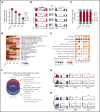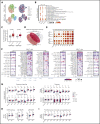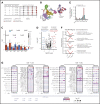Single-cell transcriptomics dissects hematopoietic cell destruction and T-cell engagement in aplastic anemia
- PMID: 33763704
- PMCID: PMC8349468
- DOI: 10.1182/blood.2020008966
Single-cell transcriptomics dissects hematopoietic cell destruction and T-cell engagement in aplastic anemia
Abstract
Aplastic anemia (AA) is a T cell-mediated autoimmune disorder of the hematopoietic system manifested by severe depletion of the hematopoietic stem and progenitor cells (HSPCs). Nonetheless, our understanding of the complex relationship between HSPCs and T cells is still obscure, mainly limited by techniques and the sparsity of HSPCs in the context of bone marrow failure. Here we performed single-cell transcriptome analysis of residual HSPCs and T cells to identify the molecular players from patients with AA. We observed that residual HSPCs in AA exhibited lineage-specific alterations in gene expression and transcriptional regulatory networks, indicating a selective disruption of distinct lineage-committed progenitor pools. In particular, HSPCs displayed frequently altered alternative splicing events and skewed patterns of polyadenylation in transcripts related to DNA damage and repair, suggesting a likely role in AA progression to myelodysplastic syndromes. We further identified cell type-specific ligand-receptor interactions as potential mediators for ongoing HSPCs destruction by T cells. By tracking patients after immunosuppressive therapy (IST), we showed that hematopoiesis remission was incomplete accompanied by IST insensitive interactions between HSPCs and T cells as well as sustained abnormal transcription state. These data collectively constitute the transcriptomic landscape of disrupted hematopoiesis in AA at single-cell resolution, providing new insights into the molecular interactions of engaged T cells with residual HSPCs and render novel therapeutic opportunities for AA.
© 2021 by The American Society of Hematology.
Figures






Similar articles
-
SWI/SNF subunit expression heterogeneity in human aplastic anemia stem/progenitors.Exp Hematol. 2018 Jun;62:39-44.e2. doi: 10.1016/j.exphem.2018.03.005. Epub 2018 Mar 27. Exp Hematol. 2018. PMID: 29596882
-
Interferon-γ-mediated selective inhibition of hematopoiesis and the clonal advantage of HLA-lacking hematopoietic stem progenitor cells in aplastic anemia.Leukemia. 2025 Jun;39(6):1490-1502. doi: 10.1038/s41375-025-02595-6. Epub 2025 Apr 11. Leukemia. 2025. PMID: 40217071
-
Single-cell analysis of aplastic anemia reveals a convergence of NK and NK-like CD8+ T cells with a disease-associated TCR signature.Sci Transl Med. 2025 Feb 26;17(787):eadl6758. doi: 10.1126/scitranslmed.adl6758. Epub 2025 Feb 26. Sci Transl Med. 2025. PMID: 40009697
-
Aplastic anemia: Pathophysiology.Semin Hematol. 2022 Jan;59(1):13-20. doi: 10.1053/j.seminhematol.2021.12.002. Epub 2022 Jan 5. Semin Hematol. 2022. PMID: 35491054 Review.
-
Origins of T-cell-mediated autoimmunity in acquired aplastic anaemia.Br J Haematol. 2025 Apr;206(4):1035-1053. doi: 10.1111/bjh.19993. Epub 2025 Jan 21. Br J Haematol. 2025. PMID: 39836983 Free PMC article. Review.
Cited by
-
Why Single-Cell Sequencing Has Promise in MDS.Front Oncol. 2021 Dec 2;11:769753. doi: 10.3389/fonc.2021.769753. eCollection 2021. Front Oncol. 2021. PMID: 34926276 Free PMC article. Review.
-
Reduced regulatory effects of bone marrow-derived mesenchymal stem cells on activated T lymphocytes and Th1/Th2 cytokine secretion in children with aplastic anemia.Clin Exp Med. 2023 Dec;23(8):4633-4646. doi: 10.1007/s10238-023-01238-3. Epub 2023 Nov 6. Clin Exp Med. 2023. PMID: 37930604
-
Adult tissue-specific stem cell interaction: novel technologies and research advances.Front Cell Dev Biol. 2023 Sep 21;11:1220694. doi: 10.3389/fcell.2023.1220694. eCollection 2023. Front Cell Dev Biol. 2023. PMID: 37808078 Free PMC article. Review.
-
ABC portal: a single-cell database and web server for blood cells.Nucleic Acids Res. 2023 Jan 6;51(D1):D792-D804. doi: 10.1093/nar/gkac646. Nucleic Acids Res. 2023. PMID: 35920330 Free PMC article.
-
Single-Cell RNA-Seq of Bone Marrow Cells in Aplastic Anemia.Front Genet. 2022 Jan 3;12:745483. doi: 10.3389/fgene.2021.745483. eCollection 2021. Front Genet. 2022. PMID: 35046994 Free PMC article.
References
-
- Maciejewski JP, Selleri C, Sato T, Anderson S, Young NS. A severe and consistent deficit in marrow and circulating primitive hematopoietic cells (long-term culture-initiating cells) in acquired aplastic anemia. Blood. 1996;88(6):1983-1991. - PubMed
-
- Maciejewski J, Selleri C, Anderson S, Young NS. Fas antigen expression on CD34+ human marrow cells is induced by interferon gamma and tumor necrosis factor alpha and potentiates cytokine-mediated hematopoietic suppression in vitro. Blood. 1995;85(11):3183-3190. - PubMed
Publication types
MeSH terms
LinkOut - more resources
Full Text Sources
Other Literature Sources
Medical
Molecular Biology Databases

